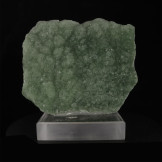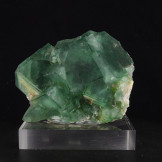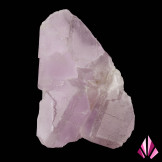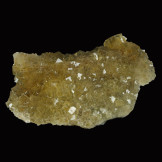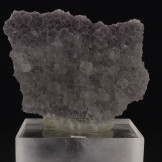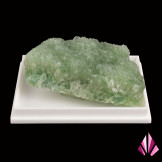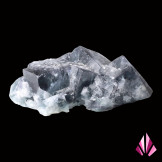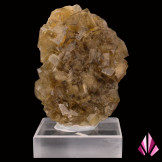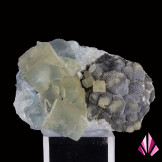Article about fluorite.
Fluorite and its Formation Process
Fluorite primarily forms in areas with high geothermal activity, such as hydrothermal veins. Its formation process is a true chemical ballet underground. Picture mineral-rich waters flowing through underground fissures. As these waters cool, the minerals within them begin to crystallize. Among them, calcium fluoride organizes into fluorite crystals. This process, spanning thousands to millions of years, culminates in the formation of these magnificent colored crystals.
The Diversity of Fluorite Colors
Fluorite is distinguished by its variety of colors, ranging from transparent to violet, green, and other hues. These color variations result from impurities present in the mineral. For example, the presence of iron may impart a violet hue, while elements such as yttrium or cerium can create shades of green.
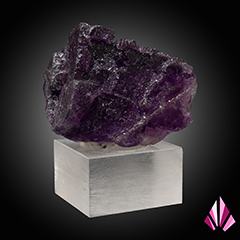
-3.jpg)
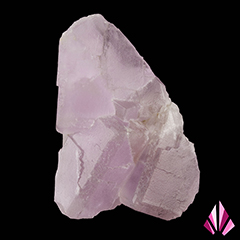
-2.jpg)
Fluorite Fluorescence
A remarkable aspect of fluorite is its ability to glow under ultraviolet light, a phenomenon known as fluorescence. This unique characteristic is the origin of the term "fluorescent" itself.
How to Identify Fluorite
Identifying fluorite among other minerals can be a rewarding task for collectors and beginner mineral enthusiasts. Here are some clues to help you identify this unique mineral:
-
Color and Transparency:
- Fluorite comes in a range of varied colors, from violet to green, yellow, blue, and pink.
- While it can be transparent, fluorite is often translucent or opaque.
- Keep in mind that color may vary depending on impurities present in the mineral.
-
Cleavage and Crystal Form:
- Fluorite exhibits perfect cleavage along four directions, forming flat faces or cubic crystals.
- Its crystals may also adopt octahedral or dodecahedral forms, depending on formation conditions.
-
Hardness and Luster:
- On the Mohs scale, fluorite has a hardness of 4, meaning it is relatively soft and can be scratched by a knife blade.
- Its luster is vitreous to sub-adamantine, giving the crystals a shiny appearance under light.
-
UV Reaction:
- A simple test to identify fluorite involves exposing a sample to ultraviolet light. If the mineral emits bright fluorescence, it is likely fluorite.
-
Acidity Test:
- Fluorite is sensitive to acids, typically reacting with diluted acids to produce fluorine gas.
Fluorite Acidity Test
Fluorite exhibits a characteristic reactivity to acids, a trait that can be used as an additional means to confirm its identification. Here's how to proceed:
-
Acid Selection:
- For this test, preferably use a diluted acid such as hydrochloric acid (HCl) or sulfuric acid (H₂SO₄) with moderate concentration.
- The acid should be handled with care, wearing appropriate protective equipment.
-
Sample Preparation:
- Select a fluorite sample to test. It can be a crystal fragment or any other fluorite specimen.
- Clean the sample to remove any dirt or impurities that may interfere with the test.
-
Acid Application:
- Place a few drops of diluted acid on the surface of the fluorite sample.
- Observe the reaction carefully.
-
Reaction Observation:
- When the acid comes into contact with fluorite, a chemical reaction typically occurs.
- You may notice effervescence or release of gas bubbles from the surface of the fluorite.
- This reaction is due to the dissolution of fluorite in the diluted acid, forming fluorine gas (usually hydrogen fluoride, HF) as a product.
-
Precautions:
- Handle the acid with caution and in a well-ventilated environment to avoid direct contact with skin or eyes.
- After the experiment, make sure to clean the sample and any equipment used thoroughly.
Fluorine cleaning
Fluorite needs to be cleaned regularly to avoid the build-up of dust and dirt that can obscure its natural brilliance. However, because of its relative softness (rated 4 on the Mohs scale), it requires gentle cleaning. We recommend using lukewarm water and mild soap, avoiding hard brushes that could scratch the surface. Instead, use a soft cloth or a brush with very soft bristles.
The Versatile Uses of Fluorite
Chemical Industry: Fluorite is a crucial element in the production of hydrofluoric acid, a major component in the manufacturing of various products, including Teflon and certain medications.
Metallurgy: It is used to purify molten metals by removing impurities.
Glass and Ceramic Manufacturing: Fluorite is employed to lower the melting temperature and improve the fluidity of materials.
Scientific and Space Domain: Fluorite's transparency to ultraviolet and infrared light makes it a preferred material for the lenses of space telescopes.
In Conclusion
Fluorite, with its colorful crystals and myriad applications, represents both a geological and industrial treasure. It speaks to the beauty hidden beneath the surface of our planet and the natural alchemy that has shaped it for millennia. More than just a mineral, fluorite provides a window into the world of geology and remains a key player in many aspects of modern life.
Don't miss our wide selection of fluorites!

